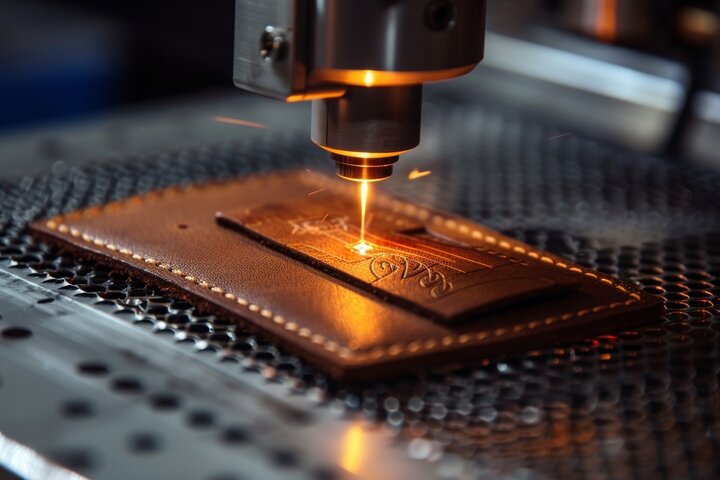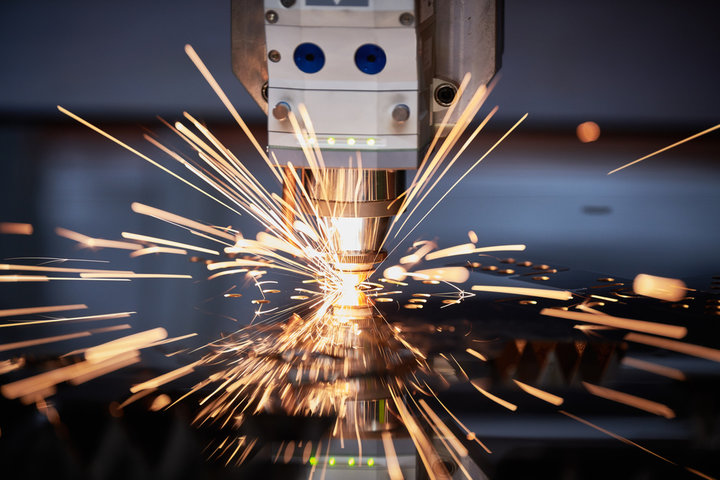Laser engraving or laser etching: which one’s right for your project? While both techniques create lasting marks, they differ in depth, durability, and applications. Choosing the correct method depends on your material, durability needs, and budget.
In this post, we’ll dive into laser engraving vs. laser etching, covering key differences in process, materials, and cost. You’ll learn when to choose each, practical industry examples, and tips for selecting the best method for your needs.
What is Laser Engraving?
Laser engraving is a precise technique that permanently marks materials by vaporizing their surface. This section explores how laser engraving works, its benefits and drawbacks, suitable materials, and common industrial applications.

Process Description
The process utilizes concentrated laser energy to vaporize material surfaces, creating precise cavity patterns. When laser beams contact the target surface, they generate intense heat, transforming solid material directly into vapor. This vaporization mechanism produces deeper cavities compared to other marking methods.
The engraving depth typically reaches up to 0.020 inches, varying based on:
Advantages of Laser Engraving
Laser engraving delivers several compelling benefits:
Long-Lasting Markings: Engraved marks are wear-resistant, making them suitable for products exposed to harsh conditions.
Heavy-Duty Applications: Its durability allows it to mark components that endure regular handling or extreme environments.
High Precision and Repeatability: Laser engraving offers excellent accuracy, ensuring consistency in high-volume production.
Broad Material Compatibility: This technique works on a wide range of materials, including metals, plastics, and even wood.
Disadvantages of Laser Engraving
Despite its strengths, laser engraving presents certain limitations:
Higher Energy Consumption: The vaporization process demands significant power input
Increased Operating Costs: Equipment maintenance and operation expenses exceed alternative methods
Material Restrictions: Some materials prove unsuitable due to their physical properties
Suitable Materials for Laser Engraving
Laser engraving accommodates numerous materials:
Metals:
Stainless Steel
Aluminum
Titanium
Brass
Non-Metallic Materials:
Wood
Fiberglass
Paper
Select Polymers
Common Applications
Laser engraving is widely used for marking parts with high durability needs. Common applications include:
Industrial Parts: Used in manufacturing to label machine components, ensuring traceability and durability.
Medical Devices: Engraving serial numbers or codes on surgical instruments for easy identification and compliance with industry standards.
Automotive and Aerospace Components: Ideal for marking parts exposed to extreme environments, providing long-lasting and readable marks.
What is Laser Etching?
Laser etching creates permanent marks through surface melting, making it ideal for precision marking across diverse materials. Here, we explore how laser etching works, its advantages and limitations, suitable materials, and common uses.

Process Description
The process employs concentrated laser beams to generate high heat energy at specific points. When the laser contacts the material surface, it triggers rapid melting and micro-level expansion. This thermal interaction causes localized changes, resulting in raised markings visible after cooling.
The mechanism involves:
Energy absorption and heat conversion
Surface melting at microscopic levels
Material expansion and texture modification
Color transformation on the surface
Typical etching depth ranges from 0.0001 to 0.001 inches, offering precise control over marking characteristics.
Advantages of Laser Etching
Laser etching delivers several compelling benefits:
High Precision: Exceptional accuracy makes it perfect for intricate designs and small details on jewelry or medical components
Rapid Production: Its speed surpasses other marking techniques, enabling efficient mass production
Cost-Effective Operation: Lower power requirements reduce operational expenses
Material Versatility: Works effectively on both thick and thin materials
Energy Efficiency: Minimal power consumption compared to alternative marking methods
Disadvantages of Laser Etching
Despite its benefits, laser etching presents certain limitations:
Durability Concerns: Since the markings are at the surface level, they may wear off over time in harsh conditions.
Equipment Restrictions: Requires specific fiber laser systems, limiting accessibility for smaller operations
Maintenance Requirements: Regular system calibration needs attention
Suitable Materials for Laser Etching
Metals:
Non-Metals:
Glass
Ceramics
Polymers
Selected acrylics
Common Applications
Laser etching is ideal for applications that don’t require deep, wear-resistant marks. It’s widely used for:
Artistic and Light Commercial Products: Suitable for items like jewelry, personalized nameplates, and custom metal products.
Part Traceability: Essential for industries where component identification is crucial, such as automotive, electronics, and aerospace.

Comparing Laser Etching and Engraving
Laser etching and engraving may appear similar but differ significantly in depth, durability, and efficiency. Here’s a detailed comparison of these methods based on key factors.
Depth of Cut
Etching: Creates shallow marks, typically between 0.0001 and 0.001 inches. This surface-level marking is ideal for designs that don’t need depth.
Engraving: Cuts deeper, up to 0.020 inches. The increased depth makes engraved markings highly visible and more permanent.
Durability and Wear Resistance
Etching: Less durable due to its shallow cuts, suited for aesthetic purposes or light-duty products.
Engraving: More durable and wear-resistant, ideal for parts used in harsh environments, such as industrial or outdoor settings.
Production Volume and Cost
Etching: More cost-effective for large-volume production. Its faster processing and lower power needs make it a budget-friendly choice.
Engraving: Higher cost due to increased time and energy. Engraving is best suited to applications where durability outweighs production cost.
Application Versatility
Etching: Compatible with a wide range of materials, including metals, glass, and certain polymers, offering flexibility in various industries.
Engraving: Limited mostly to metals and some organic materials, such as wood, due to its higher power requirements.
Speed and Efficiency
Etching: Faster process, ideal for high-speed production environments or short-run projects.
Engraving: Slower but more detailed, making it the preferred choice for intricate, permanent designs that require precision.
Environmental Impact
Laser etching generally consumes less power than engraving, making it the more eco-friendly option for applications that don’t require depth or durability. Engraving requires more energy, which can increase operational costs and environmental impact.
| Comparison Factor | Laser Etching | Laser Engraving |
| Depth of Cut | Shallow (0.0001 - 0.001 inches) | Deep (up to 0.020 inches) |
| Durability | Less durable, for aesthetic purposes | Highly durable, suitable for harsh environments |
| Cost | Cost-effective for high volume | Higher due to time and power needs |
| Material Compatibility | Broad range (metals, glass, polymers) | Primarily metals and specific organics |
| Speed | Faster | Slower but more detailed |
| Eco-Friendliness | Lower power consumption | Higher power consumption |
Factors to Consider When Choosing Between Laser Engraving and Laser Etching
When deciding between laser engraving and laser etching, it’s essential to consider various factors like material compatibility, mark durability, production needs, and budget.

Material Properties and Compatibility
The type of material significantly influences the decision. Laser etching is compatible with a broad range of materials, including metals, glass, and some plastics, making it ideal for versatile applications. Laser engraving, however, is more limited to metals and certain organic materials (like wood) due to its higher power requirements.
Desired Depth and Durability of Marks
Engraving for Deep Marks: If your project requires deeper markings (over 0.02 inches), engraving is the ideal choice. Its depth provides extra durability, suitable for products exposed to harsh conditions.
Etching for Production Efficiency: Etching is about twice as fast as engraving, making it ideal for high-speed production where depth isn’t critical.
Cost-Sensitive Applications: For projects with tight budgets, etching is generally more cost-effective due to its lower power and material requirements.
Production Volume and Speed Requirements
For large-scale production, speed and efficiency become critical. Laser etching’s faster processing time allows for higher production volumes, making it suitable for mass-marked items. In contrast, engraving’s slower speed is best for low-volume or specialized items that demand longevity.
Budget and Cost Considerations
Budget can be a major deciding factor. Laser engraving tends to have higher upfront and operational costs due to increased power needs and longer processing times. Laser etching, which requires less energy, offers a more economical option for budget-conscious projects, especially in high-volume production.
Aesthetic Preferences and Design Complexity
For intricate or detailed designs, both etching and engraving can deliver excellent results. However, etching’s surface-level marks are ideal for delicate, high-precision designs, such as logos or serial numbers on light commercial items. Engraving is better suited to creating highly durable, tactile designs for parts exposed to heavy wear.
| Factor | Recommended Process |
| Material Compatibility | Etching (broader range) |
| Desired Depth | Engraving (0.02 inches or more) |
| Production Efficiency | Etching (2x faster) |
| Budget | Etching (cost-effective) |
| Aesthetic Complexity | Etching (precision designs) |
| Durability | Engraving (high-wear parts) |
Summary
In summary, laser engraving and laser etching differ in depth, durability, and processing speed. Engraving creates deeper, longer-lasting marks, while etching offers faster, surface-level markings. Choosing the right method is crucial for achieving the desired results in specific applications. It ensures that marks meet durability, cost, and aesthetic needs.
Consider key factors like material compatibility, production speed, and budget when deciding. Consulting experts can provide guidance for complex projects. By understanding these differences, you can make informed choices for your needs in laser engraving vs. laser etching.
Reference Sources
Laser engraving
FAQs
Q: What materials can be laser engraved or etched?
A: Surface marking works effectively on various materials. Metal manufacturing processes support steel, aluminum, brass for both methods. Material treatment extends to glass, ceramics, polymers for etching, while material processing excels on wood, fiberglass for engraving. Surface working capabilities depend on substrate layer properties.
Q: How long do laser-engraved or laser-etched marks last?
A: Permanent identification through etching typically provides 5-10 years of durability under normal conditions. Deep marking through engraving creates enduring marks, offering superior indelible marks ideal for harsh industrial applications.
Q: Can laser engraving and etching be used for color marking?
A: Surface modification through etching produces black, white, or gray material branding. Thermal processing affects color variation based on workpiece exterior absorption and reflection ratios during identification process.
Q: What are the typical costs associated with laser engraving and etching?
A: Material alteration through etching requires lower operational costs. Deep marking expenses increase due to extended processing times, higher energy consumption, material hardness, and manufacturing capacity requirements.
Q: How do I choose the right laser machine for my engraving or etching needs?
A: Select optical systems based on manufacturing purposes. Laser machinery selection depends on outer layer composition, production scale requirements, beam source efficiency, and batch size demands.
Q: What is the processing speed of laser engraving/etching?
A: Surface labeling through etching achieves twice the output level of engraving. Manufacturing quantity affects speed, varying by base material properties and design complexity.
Q: How do the material requirements differ between the two methods?
A: Surface modification through etching suits reflective substrate layers. Material vaporization through engraving adapts to harder materials needing lasting impressions. Material forming success depends on absorption characteristics.
Q: What are the maintenance and upkeep considerations for laser processing equipment?
A: Professional uses require regular marking equipment calibration. Laser systems for material removal need frequent maintenance due to intensive business applications. Both demand controlled metallurgical process environments.
For more questions, contact TEAM MFG today!



















